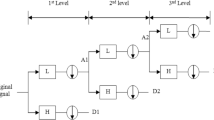Abstract
Defects in rolling element bearings are foremost cause of failure in rotating machines. The accurate and fast diagnosis of bearing defects like spall, dents, pits, cracks etc. on the various component of bearing can be accomplished by analysis of vibration signals using various advanced signal processing techniques. In this work, a new technique for the diagnosis of bearing defects using tunable Q-wavelet transform and fractal based features has been presented. The vibration signals have been recorded experimentally. These signals are decomposed into a number of sub-bands using tunable Q-wavelet transform for effective feature extraction. Classical statistical features and fractal dimension based features such as Higuchi fractal dimensions and Katz fractal dimensions are computed for each decomposed sub-band. These features obtained using tunable Q-wavelet transform of vibration signal are having better capability to classify defects through various machine learning algorithms.
Similar content being viewed by others
References
N. Vyas and D. Satishkumar, Artificial neural network design for fault identification in a rotor-bearing system, Mech. Mach. Theory, 36 (2001) 157–175.
B. Samanta and K. R. Al-Balushi, Artificial neural network based fault diagnostics of rolling element bearings using time-domain features, Mech. Syst. Signal Process, 17 (2003) 317–328.
Y. Yang, D. Yu and J. Cheng, A fault diagnosis approach for roller bearing based on IMF envelope spectrum and SVM, Meas. J. Int. Meas. Confed., 40 (2007) 943–950.
P. K. Kankar, S. C. Sharma and S. P. Harsha, Fault diagnosis of ball bearings using machine learning methods, Expert Syst. Appl., 38 (2011) 1876–1886.
S. Kavathekar, N. Upadhyay and P. K. Kankar, Fault classification of ball bearing by rotation forest technique, Procedia Technol., 23 (2016) 187–192.
B. A. Paya, I. I. Esat and M. N. M. Badi, Artificial neural network based fault diagnostics of rotating machinery using wavelet transforms as a preprocessor, Mech. Syst. Signal Process., 11 (1997) 751–765.
V. Purushotham, S. Narayanan and S. A. N. Prasad, Multifault diagnosis of rolling bearing elements using wavelet analysis and hidden Markov model based fault recognition, NDT E Int., 38 (2005) 654–664.
J. Rafiee, P. W. Tse, A. Harifi and M. H. Sadeghi, A novel technique for selecting mother wavelet function using an intelligent fault diagnosis system, Expert Syst. Appl., 36 (2009) 4862–4875.
P. K. Kankar, S. C. Sharma and S. P. Harsha, Fault diagnosis of ball bearings using continuous wavelet transform, Appl. Soft Comput. J., 11 (2011) 2300–2312.
V. Vakharia, V. K. Gupta and P. K. Kankar, Efficient fault diagnosis of ball bearing using relieff and random forest classifier, J. Brazilian Soc. Mech. Sci. Eng., 39 (2017) 2969–2982.
I. W. Selesnick, Wavelet transform with tunable Q-factor, IEEE Trans. Signal Process., 59 (2011) 3560–3575.
S. Patidar and R. B. Pachori, Classification of cardiac sound signals using constrained tunable-Q wavelet transform, Expert Syst. Appl., 41 (2014) 7161–7170.
S. Patidar, R. B. Pachori and N. Garg, Automatic diagnosis of septal defects based on tunable-Q wavelet transform of cardiac sound signals, Expert Syst. Appl., 42 (2015) 3315–3326.
J. Metsebo, N. Upadhyay and P. K. Kankar, BRN Nbendjo, Modelling of a rotor-ball bearings system using Timoshenko beam and effects of rotating shaft on their dynamics, J. Mech. Sci. Technol., 30 (2016) 5339–5350.
C. Cortes and V. Vapnik, Support-vector networks, Mach. Learn., 20 (1995) 273–297.
J. A. K. Suykens and J. Vandewalle, Least squares support vector machine classifiers, Neural Process. Lett., 9 (1999) 293–300.
J. A. K. Suykens, T. V. Gestel, J. D. Brabanter, B. D. Moore and J. Vandewalle, Least squares support vector machine, World Scientific Publication (2002).
S. Haykin, Neural networks-A comprehensive foundation, Second Ed., Prentice Hall (1998).
Y. Peng, P. Flach, P. Brazdil and C. Soares, Decision treebased data characterization for meta-learning, 2nd Int. Work. Integr. Collab. Asp. Data Mining, Decis. Support Meta-Learning, IDDM’ 02 (2002) 111–122.
J. R. Quinlan, Improved use of continuous attributes in C4.5, J. Artif. Intell. Res., 4 (1996) 77–90.
N. Saravanan, V. N. S. Kumar Siddabattuni and K. I. Ramachandran, A comparative study on classification of features by SVM and PSVM extracted using Morlet wavelet for fault diagnosis of spur bevel gear box, Expert Syst. Appl., 35 (2008) 1351–1366.
T. Higuchi, Approach to an irregular time series on the basis of the fractal theory, Physica D, 31 (1988) 277–283.
B. B. Mandelbrot, The fractal geometry of nature, First Ed., W. H. Freeman & Company, New York (1982).
M. Katz, Fractals and the analysis of waveforms, Comput. Biol. Med., 18 (1988) 145–56.
Author information
Authors and Affiliations
Corresponding author
Additional information
Recommended by Associate Editor Byeng Dong Youn
Nitin Upadhyay received Master of Technology (M.Tech.) in Industrial Engineering and Management from National Institute of Technology, Tiruchirappalli, India. Currently he is a Ph.D. student at the Mechanical Engineering Discipline, PDPM Indian Institute of Information Technology, Design and Manufacturing, Jabalpur, India. His current research areas are Non-linear dynamics, Fault diagnosis of rotor bearing system, condition monitoring and signal processing.
P. K. Kankar is working as an Assistant Professor in Mechanical Engineering Discipline, PDPM-Indian Institute of Information Technology, Design and Manufacturing Jabalpur. He is having more than 10 years of teaching and research experience. He obtained his Ph.D. from the Mechanical and Industrial Engineering Department at Indian Institute of Technology Roorkee, India. His research interests include vibration, design, condition monitoring of mechanical components, nonlinear dynamics, soft computing etc.
Rights and permissions
About this article
Cite this article
Upadhyay, N., Kankar, P.K. Diagnosis of bearing defects using tunable Q-wavelet transform. J Mech Sci Technol 32, 549–558 (2018). https://doi.org/10.1007/s12206-018-0102-8
Received:
Revised:
Accepted:
Published:
Issue Date:
DOI: https://doi.org/10.1007/s12206-018-0102-8




